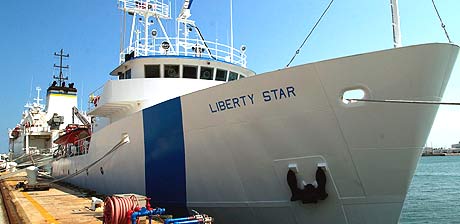| Scientists
to check reef's recovery April 28, 2003 CAPE CANAVERAL -- Biologists and robotics experts Monday loaded up the same ship used to haul back spent space shuttle tanks with gizmos to watch and listen to deep sea fish spawn along a rare, brittle reef. "A lot of it now has been reduced to a rubble mat," said Andrew Shepard, associate director of National Undersea Research Center in Wilmington, N.C. Shepard knelt next to an underwater vehicle that will scan the Oculina Bank, a jagged reef about 25 miles off Cape Canaveral that stretches as far south as Fort Pierce. He and several other researchers will watch the reef for 10 days to find out whether it has recovered since the federal government closed the reef to bottom fishing a decade ago. Their findings could be used to help boost reef conservation. The trip brings in scientists from Harbor Branch Oceanographic Institution in Fort Pierce; Dynamac Corp., a consultant to NASA; and the National Oceanic and Atmospheric Administration. They'll broadcast findings live on the Web and keep a daily log for school students to track the mission. The mission is a follow-up to one last fall in which the scientists used multi-beam sonar to map where the Oculina varicosa coral grows. They'll do so with video cameras and microphones set on robots. The end goal is to determine whether the rare reef needs more protection. "This reef is like old growth forest. They're about the size of a basketball," said John Reed, a researcher at Harbor Branch explained from the deck of the Liberty Star. Each coral hosts up to 2,000 individual animals such as shrimp, worms and crabs. "That coral head is kind of like a condominium," he said. The coral can sprout up to 100 feet from the ocean floor. Prized ocean delicacies, such as grouper, snapper and rock shrimp, spawn and hide there. But shrimpers poaching in protected areas have dragged nets through the coral for decades, prompting scientists and regulators to take a closer look at where it grows. Also called ivory tree coral, Oculina varicosa grows slowly in deep water -- up to 300 feet deep. Biologists suspect rich plankton of the Gulf Stream, or cold water upwelling from the Florida Straits, make the coral grow only in this area. Although shallow-water coral reefs can grow as much as 10 nches a year, Oculina grows about a half-inch. It sprouts out into 3- to 5-foot-long branches about the diameter of a human finger. Crushed with one drag of a net, the coral can take hundreds of years to grow back. Even deep-sea fishing weights can shatter the fragile coral. The area is trawled for rock shrimp and scallops. Shrimpers net along the fringes of the protected areas, and sometimes within the protected areas. It's a more barren reef than the one Reed dove to survey 30 years ago, crushed by decades of fishing and shrimping. "The biggest change from the '70s is that everybody now has a hand-held GPS," Reed said. "With our high-definition fish finders, it's very easy to see fish spawning." By the late 1980s, the reef began to show signs of heavy fishing damage. Reed nominated the reef for federal protection in 1981. Three years later, National Marine Fisheries Service declared the southern portion of the reef, near Fort Pierce, a federal reserve, banning shrimp trawling. In 1994, the federal agency also closed the 90 square miles of the reef to bottom fishing for 10 years. The designation expires in 2004. The agency will decide this year whether to extend the ban. About three years ago, the federal government added another 300 square miles to the north, expanding the protected area to 60 miles, from Fort Pierce to Cape Canaveral. Migrating species, such as mackerel, dolphin, tuna, and wahoo, use the reef. But it had been most prized for grouper and snapper there. It will take years before a stable breeding population of grouper returns, biologists said. They hope for more opportunities to use the 176-foot Liberty Star, operated by the United Space Alliance. The ship is one of two the space agency uses to recover the shuttle's two fuel tanks after launches. "We'll coordinate with them as needed, around the launch schedule," said Joseph Chaput, manager of marine operations for United Space Alliance. |
| |
 The
NASA ship Liberty Star will leave Port Canaveral today with underwater
scientific gear. Image copyright © 2003, Delinda
The
NASA ship Liberty Star will leave Port Canaveral today with underwater
scientific gear. Image copyright © 2003, Delinda